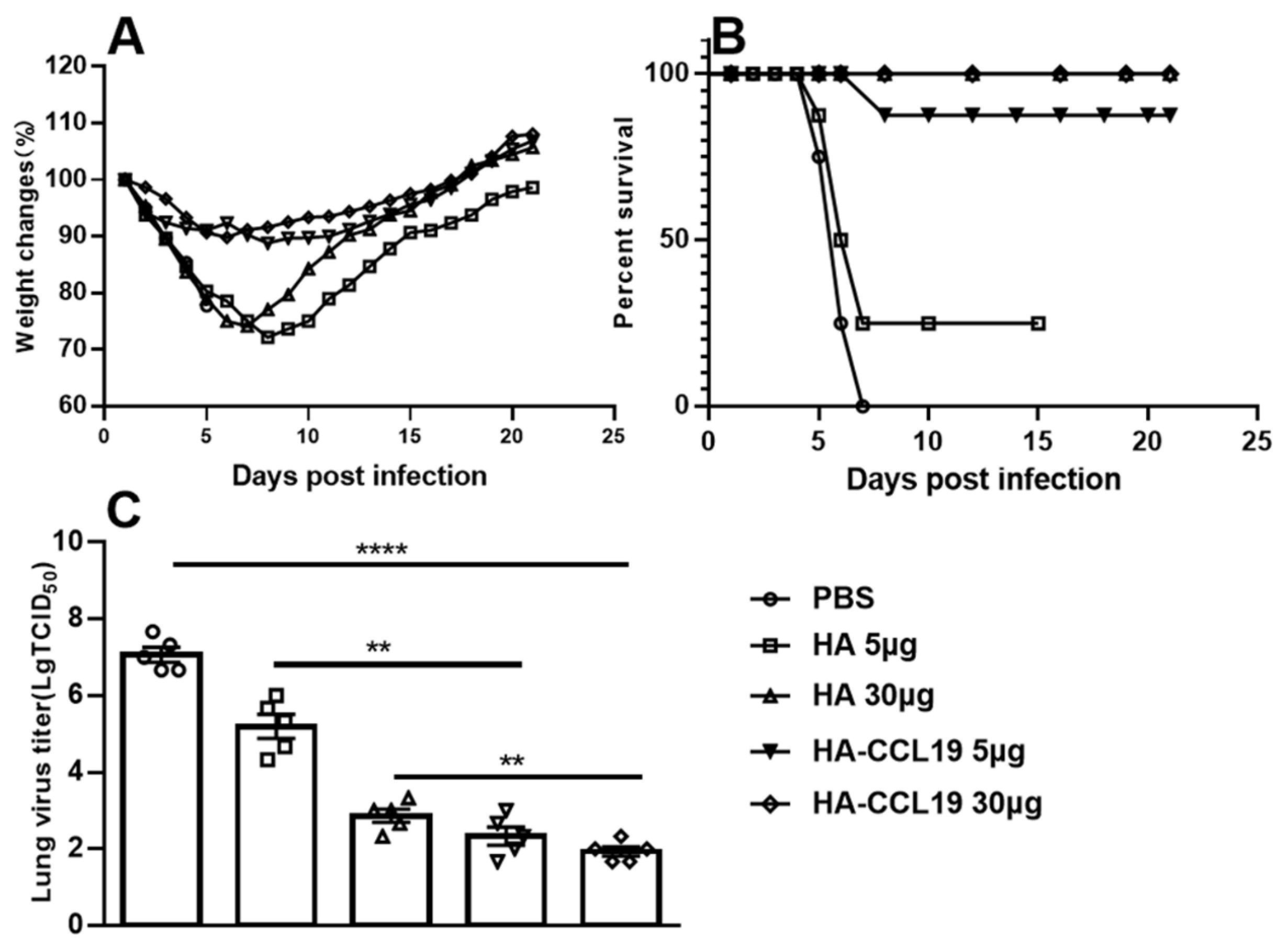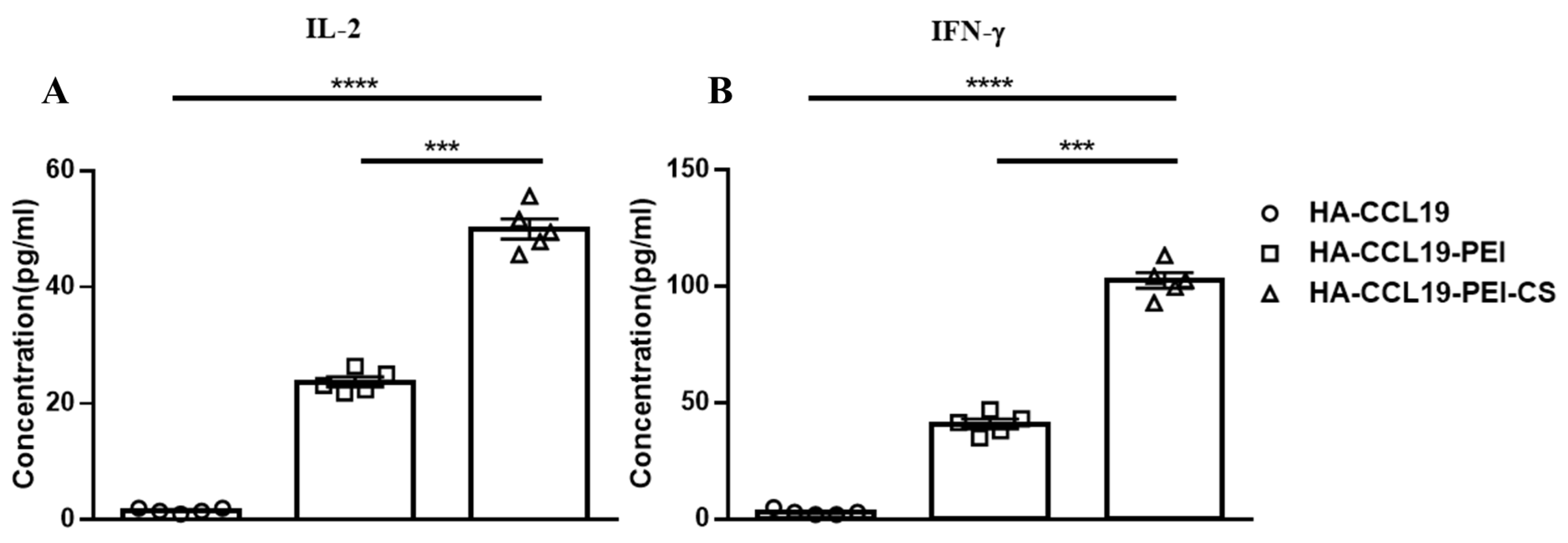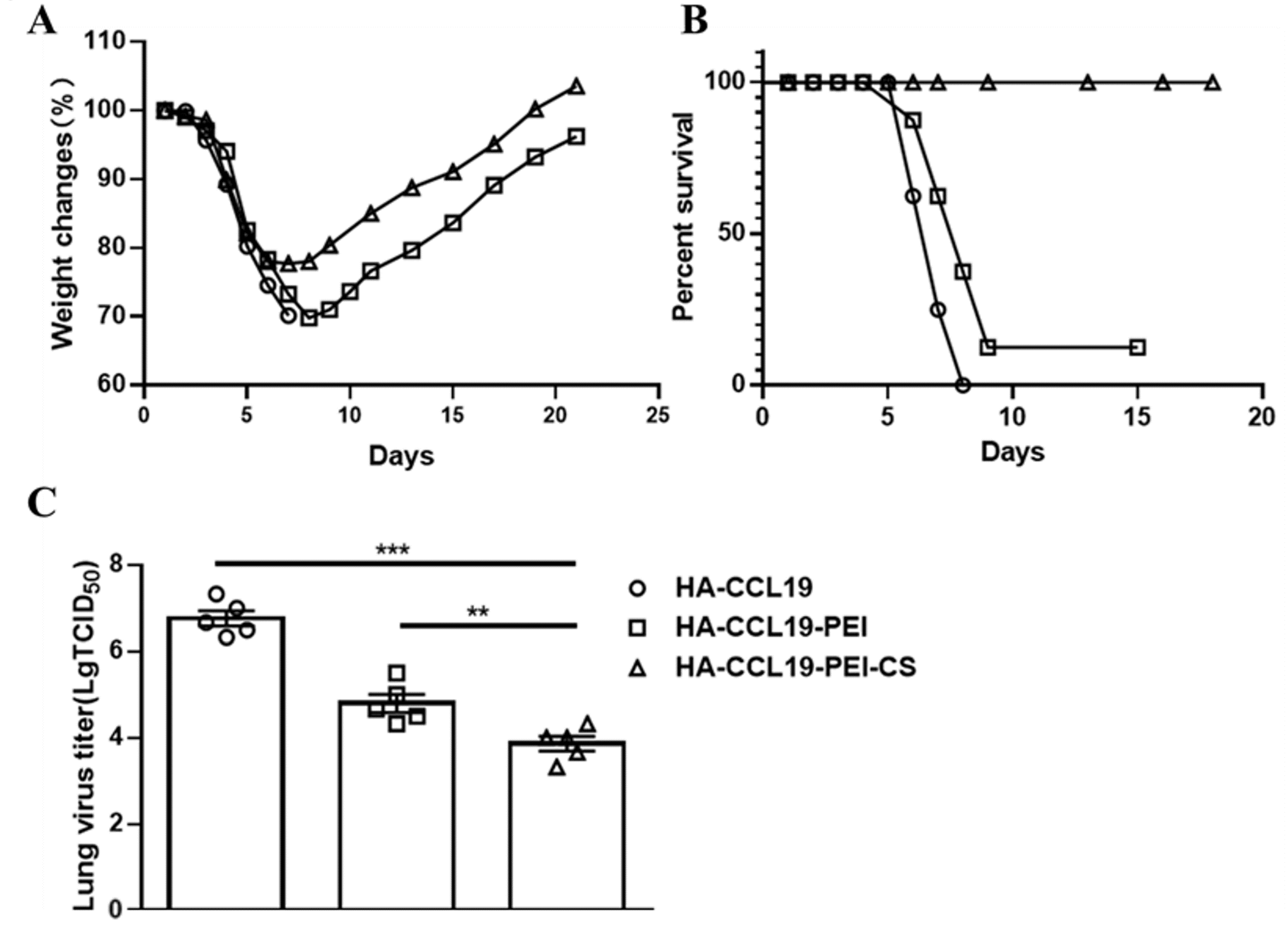Intranasal Immunization with DNA Vaccine HA-CCL19/Polyethylenimine/Chitosan Composite Provides Immune Protection Against H7N9 Infection
Abstract
1. Introduction
2. Materials and Methods
2.1. Viruses and Plasmids
2.2. Animal Immunization and Challenge
2.3. Fabrication of PEI-CS Composite
2.4. Quantitative Analysis of Antibodies Through ELISA
2.5. Hemagglutination Inhibition Assay
2.6. Cytokine Assays
2.7. Statistical Analysis
3. Results
3.1. Antibody Response Induced by Intramuscular Immunization
3.2. Cellular Immune Responses Generated by Intramuscular Injection
3.3. Protection Against Lethal Virus Challenge Provided by Intramuscular Injection
3.4. Antibody Response Subsequent to Intranasal Mucosal Immunization
3.5. Cellular Immune Responses Induced by Intranasal Inoculation
3.6. Protection Against Lethal Virus Challenge Provided by Intranasal Inoculation
4. Discussion
5. Conclusions
Author Contributions
Funding
Institutional Review Board Statement
Informed Consent Statement
Data Availability Statement
Conflicts of Interest
References
- Spackman, E. A Brief Introduction to Avian Influenza Virus. Methods Mol. Biol. 2020, 2123, 83–92. [Google Scholar] [PubMed]
- Emerging Pathogens: Influenza—H7n9. Dis. Mon. 2017, 63, 251–256. [CrossRef] [PubMed]
- Nuwarda, R.F.; Alharbi, A.A.; Kayser, V. An Overview of Influenza Viruses and Vaccines. Vaccines 2021, 9, 1032. [Google Scholar] [CrossRef] [PubMed]
- Lee, L.Y.Y.; Izzard, L.; Hurt, A.C. A Review of DNA Vaccines Against Influenza. Front. Immunol. 2018, 9, 1568. [Google Scholar] [CrossRef]
- Andersen, T.K.; Bodin, J.; Oftung, F.; Bogen, B.; Mjaaland, S.; Grodeland, G. Pandemic Preparedness Against Influenza: DNA Vaccine for Rapid Relief. Front. Immunol. 2021, 12, 747032. [Google Scholar] [CrossRef] [PubMed]
- Dai, J.; Pei, D.; Wang, B.; Kuang, Y.; Ren, L.; Cao, K.; Wang, H.; Zuo, B.; Shao, J.; Li, S.; et al. Molecular adjuvant Ag85A enhances protection against influenza A virus in mice following DNA vaccination. Viruses 2012, 4, 3606–3624. [Google Scholar] [CrossRef] [PubMed]
- Dehghan, A.; Shahsavandi, S.; Jabalameli, L. Improvement Efficacy of Influenza Nanovaccine in Combination with Hemokinin-1 Molecular Adjuvant. Avicenna J. Med. Biotechnol. 2018, 10, 208–213. [Google Scholar] [PubMed]
- Fagone, P.; Shedlock, D.J.; Bao, H.; Kawalekar, O.U.; Yan, J.; Gupta, D.; Morrow, M.P.; Patel, A.; Kobinger, G.P.; Muthumani, K.; et al. Molecular adjuvant HMGB1 enhances anti-influenza immunity during DNA vaccination. Gene Ther. 2011, 18, 1070–1077. [Google Scholar] [CrossRef] [PubMed]
- Fang, Y.; Rowe, T.; Leon, A.J.; Banner, D.; Danesh, A.; Xu, L.; Ran, L.; Bosinger, S.E.; Guan, Y.; Chen, H.; et al. Molecular characterization of in vivo adjuvant activity in ferrets vaccinated against influenza virus. J. Virol. 2010, 84, 8369–8388. [Google Scholar] [CrossRef]
- Yamamoto, T.; Hirano, M.; Mitsunaga, F.; Wasaki, K.; Kotani, A.; Tajima, K.; Nakamura, S. Molecular Events in Immune Responses to Sublingual Influenza Vaccine with Hemagglutinin Antigen and Poly(I:C) Adjuvant in Nonhuman Primates, Cynomolgus Macaques. Vaccines 2024, 12, 643. [Google Scholar] [CrossRef] [PubMed]
- Cao, M.; Sasaki, O.; Yamada, A.; Imanishi, J. Enhancement of the protective effect of inactivated influenza virus vaccine by cytokines. Vaccine 1992, 10, 238–242. [Google Scholar] [CrossRef] [PubMed]
- Geeraedts, F.; Bungener, L.; Pool, J.; Ter Veer, W.; Wilschut, J.; Huckriede, A. Whole inactivated virus influenza vaccine is superior to subunit vaccine in inducing immune responses and secretion of proinflammatory cytokines by DCs. Influenza Other Respir. Viruses 2008, 2, 41–51. [Google Scholar] [CrossRef]
- Kayamuro, H.; Yoshioka, Y.; Abe, Y.; Arita, S.; Katayama, K.; Nomura, T.; Yoshikawa, T.; Kubota-Koketsu, R.; Ikuta, K.; Okamoto, S.; et al. Interleukin-1 family cytokines as mucosal vaccine adjuvants for induction of protective immunity against influenza virus. J. Virol. 2010, 84, 12703–12712. [Google Scholar] [CrossRef] [PubMed]
- Taheri, M.; Nemattalab, M.; Mahjoob, M.; Hasan-Alizadeh, E.; Zamani, N.; Nikokar, I.; Evazalipour, M.; Soltani Tehrani, B.; Shenagari, M. Toward a universal influenza virus vaccine: Some cytokines may fulfill the request. Cytokine 2021, 148, 155703. [Google Scholar] [CrossRef] [PubMed]
- Suschak, J.J.; Williams, J.A.; Schmaljohn, C.S. Advancements in DNA vaccine vectors, non-mechanical delivery methods, and molecular adjuvants to increase immunogenicity. Hum. Vaccines Immunother. 2017, 13, 2837–2848. [Google Scholar] [CrossRef] [PubMed]
- Nguyen-Hoai, T.; Hohn, O.; Vu, M.D.; Baldenhofer, G.; Sayed Ahmed, M.S.; Dorken, B.; Norley, S.; Lipp, M.; Pezzutto, A.; Westermann, J. CCL19 as an adjuvant for intradermal gene gun immunization in a Her2/neu mouse tumor model: Improved vaccine efficacy and a role for B cells as APC. Cancer Gene Ther. 2012, 19, 880–887. [Google Scholar] [CrossRef] [PubMed]
- Xu, H.; Xing, J.; Tang, X.; Sheng, X.; Zhan, W. The effects of CCL3, CCL4, CCL19 and CCL21 as molecular adjuvants on the immune response to VAA DNA vaccine in flounder (Paralichthys olivaceus). Dev. Comp. Immunol. 2020, 103, 103492. [Google Scholar] [CrossRef]
- Yan, Y.H.; Qi, S.C.; Su, L.K.; Xu, Q.A.; Fan, M.W. Co-delivery of ccl19 gene enhances anti-caries DNA vaccine pCIA-P immunogenicity in mice by increasing dendritic cell migration to secondary lymphoid tissues. Acta Pharmacol. Sin. 2013, 34, 432–440. [Google Scholar] [CrossRef]
- Yan, Y.H.; Yu, F.; Zeng, C.; Cao, L.H.; Zhang, Z.; Xu, Q.A. CCL17 combined with CCL19 as a nasal adjuvant enhances the immunogenicity of an anti-caries DNA vaccine in rodents. Acta Pharmacol. Sin. 2016, 37, 1229–1236. [Google Scholar] [CrossRef] [PubMed]
- Pachuk, C.J.; McCallus, D.E.; Weiner, D.B.; Satishchandran, C. DNA vaccines—Challenges in delivery. Curr. Opin. Mol. Ther. 2000, 2, 188–198. [Google Scholar]
- Mettelman, R.C.; Allen, E.K.; Thomas, P.G. Mucosal immune responses to infection and vaccination in the respiratory tract. Immunity 2022, 55, 749–780. [Google Scholar] [CrossRef] [PubMed]
- Palumbo, R.N.; Zhong, X.; Wang, C. Polymer-mediated DNA vaccine delivery via bystander cells requires a proper balance between transfection efficiency and cytotoxicity. J. Control. Release 2012, 157, 86–93. [Google Scholar] [CrossRef] [PubMed]
- Wegmann, F.; Gartlan, K.H.; Harandi, A.M.; Brinckmann, S.A.; Coccia, M.; Hillson, W.R.; Kok, W.L.; Cole, S.; Ho, L.P.; Lambe, T.; et al. Polyethyleneimine is a potent mucosal adjuvant for viral glycoprotein antigens. Nat. Biotechnol. 2012, 30, 883–888. [Google Scholar] [CrossRef]
- Wong, K.; Sun, G.; Zhang, X.; Dai, H.; Liu, Y.; He, C.; Leong, K.W. PEI-g-chitosan, a novel gene delivery system with transfection efficiency comparable to polyethylenimine in vitro and after liver administration in vivo. Bioconjug. Chem. 2006, 17, 152–158. [Google Scholar] [CrossRef] [PubMed]
- Shen, C.; Li, J.; Zhang, Y.; Li, Y.; Shen, G.; Zhu, J.; Tao, J. Polyethylenimine-based micro/nanoparticles as vaccine adjuvants. Int. J. Nanomed. 2017, 12, 5443–5460. [Google Scholar] [CrossRef] [PubMed]
- Zheng, D.; Chen, S.; Qu, D.; Chen, J.; Wang, F.; Zhang, R.; Chen, Z. Influenza H7N9 LAH-HBc virus-like particle vaccine with adjuvant protects mice against homologous and heterologous influenza viruses. Vaccine 2016, 34, 6464–6471. [Google Scholar] [CrossRef] [PubMed]
- Wu, J.; Wang, F.; Fang, F.; Zhang, W.; Chang, H.; Zheng, L.; Chen, Z. Superior protection provided by a single dose of MF59-adjuvanted whole inactivated H5N1 influenza vaccine in type 1 diabetic mice. Arch. Virol. 2011, 156, 387–395. [Google Scholar] [CrossRef]
- Morales, K.F.; Brown, D.W.; Dumolard, L.; Steulet, C.; Vilajeliu, A.; Ropero Alvarez, A.M.; Moen, A.; Friede, M.; Lambach, P. Seasonal influenza vaccination policies in the 194 WHO Member States: The evolution of global influenza pandemic preparedness and the challenge of sustaining equitable vaccine access. Vaccine X 2021, 8, 100097. [Google Scholar] [CrossRef] [PubMed]
- Sambala, E.Z.; Ngcobo, N.; Machingaidze, S.; Wiyeh, A.B.; Mahasha, P.W.; Jaca, A.; Cooper, S.; Wiysonge, C.S. A global review of seasonal influenza vaccine introduction: Analysis of the WHO/UNICEF Joint Reporting Form. Expert. Rev. Vaccines 2019, 18, 859–865. [Google Scholar] [CrossRef] [PubMed]
- Nakano, K.; Whitehead, G.S.; Lyons-Cohen, M.R.; Grimm, S.A.; Wilkinson, C.L.; Izumi, G.; Livraghi-Butrico, A.; Cook, D.N.; Nakano, H. Chemokine CCL19 promotes type 2 T-cell differentiation and allergic airway inflammation. J. Allergy Clin. Immunol. 2024, 153, 487–502.e9. [Google Scholar] [CrossRef]
- Comerford, I.; Harata-Lee, Y.; Bunting, M.D.; Gregor, C.; Kara, E.E.; McColl, S.R. A myriad of functions and complex regulation of the CCR7/CCL19/CCL21 chemokine axis in the adaptive immune system. Cytokine Growth Factor Rev. 2013, 24, 269–283. [Google Scholar] [CrossRef] [PubMed]
- Yanagawa, Y.; Onoe, K. CCR7 ligands induce rapid endocytosis in mature dendritic cells with concomitant up-regulation of Cdc42 and Rac activities. Blood 2003, 101, 4923–4929. [Google Scholar] [CrossRef]
- Marsland, B.J.; Battig, P.; Bauer, M.; Ruedl, C.; Lassing, U.; Beerli, R.R.; Dietmeier, K.; Ivanova, L.; Pfister, T.; Vogt, L.; et al. CCL19 and CCL21 induce a potent proinflammatory differentiation program in licensed dendritic cells. Immunity 2005, 22, 493–505. [Google Scholar] [CrossRef] [PubMed]
- Leon, A.N.; Rodriguez, A.J.; Richey, S.T.; de la Pena, A.T.; Wolters, R.M.; Jackson, A.M.; Webb, K.; Creech, C.B.; Yoder, S.; Mudd, P.A.; et al. Structural Mapping of Polyclonal IgG Responses to HA After Influenza Virus Vaccination or Infection. bioRxiv 2024. [Google Scholar] [CrossRef]
- Jorgovanovic, D.; Song, M.; Wang, L.; Zhang, Y. Roles of IFN-gamma in tumor progression and regression: A review. Biomark. Res. 2020, 8, 49. [Google Scholar] [CrossRef] [PubMed]
- Abbas, A.K.; Trotta, E.; Simeonov, D.R.; Marson, A.; Bluestone, J.A. Revisiting IL-2: Biology and therapeutic prospects. Sci. Immunol. 2018, 3, eaat1482. [Google Scholar] [CrossRef] [PubMed]
- Li, M.; Wang, Y.; Sun, Y.; Cui, H.; Zhu, S.J.; Qiu, H.J. Mucosal vaccines: Strategies and challenges. Immunol. Lett. 2020, 217, 116–125. [Google Scholar] [CrossRef] [PubMed]
- Li, Y.; Jin, L.; Chen, T. The Effects of Secretory IgA in the Mucosal Immune System. Biomed. Res. Int. 2020, 2020, 2032057. [Google Scholar] [CrossRef]
- Date, Y.; Ebisawa, M.; Fukuda, S.; Shima, H.; Obata, Y.; Takahashi, D.; Kato, T.; Hanazato, M.; Nakato, G.; Williams, I.R.; et al. NALT M cells are important for immune induction for the common mucosal immune system. Int. Immunol. 2017, 29, 471–478. [Google Scholar] [CrossRef]
- Torrieri-Dramard, L.; Lambrecht, B.; Ferreira, H.L.; Van den Berg, T.; Klatzmann, D.; Bellier, B. Intranasal DNA vaccination induces potent mucosal and systemic immune responses and cross-protective immunity against influenza viruses. Mol. Ther. 2011, 19, 602–611. [Google Scholar] [CrossRef] [PubMed]
- Wang, J.J.; Zeng, Z.W.; Xiao, R.Z.; Xie, T.; Zhou, G.L.; Zhan, X.R.; Wang, S.L. Recent advances of chitosan nanoparticles as drug carriers. Int. J. Nanomed. 2011, 6, 765–774. [Google Scholar]
- Illum, L.; Jabbal-Gill, I.; Hinchcliffe, M.; Fisher, A.N.; Davis, S.S. Chitosan as a novel nasal delivery system for vaccines. Adv. Drug Deliv. Rev. 2001, 51, 81–96. [Google Scholar] [CrossRef] [PubMed]
- Boussif, O.; Lezoualc’h, F.; Zanta, M.A.; Mergny, M.D.; Scherman, D.; Demeneix, B.; Behr, J.P. A versatile vector for gene and oligonucleotide transfer into cells in culture and in vivo: Polyethylenimine. Proc. Natl. Acad. Sci. USA 1995, 92, 7297–7301. [Google Scholar] [CrossRef] [PubMed]
- Casper, J.; Schenk, S.H.; Parhizkar, E.; Detampel, P.; Dehshahri, A.; Huwyler, J. Polyethylenimine (PEI) in gene therapy: Current status and clinical applications. J. Control. Release 2023, 362, 667–691. [Google Scholar] [CrossRef] [PubMed]
- Abu Elella, M.H.; Kolawole, O.M. Recent advances in modified chitosan-based drug delivery systems for transmucosal applications: A comprehensive review. Int. J. Biol. Macromol. 2024, 277 Pt 4, 134531. [Google Scholar] [CrossRef] [PubMed]
- Saadh, M.J.; Hsu, C.Y.; Mustafa, M.A.; Mutee, A.F.; Kaur, I.; Ghildiyal, P.; Ali, A.A.; Adil, M.; Ali, M.S.; Alsaikhan, F.; et al. Advances in chitosan-based blends as potential drug delivery systems: A review. Int. J. Biol. Macromol. 2024, 273 Pt 1, 132916. [Google Scholar] [CrossRef] [PubMed]





| Group | Serum IgG Titer (2n) After First Immunization a | Serum IgG Titer (2n) After Second Immunization a | HI Titer (2n) a |
|---|---|---|---|
| PBS | ― | ― | ND |
| HA 5 μg | 6.33 ± 0.58 b,c | 12.67 ± 0.58 b,c | 3.33 ± 1.52 b,c |
| HA 30 μg | 11.33 ± 0.58 b,c,d | 18.33 ± 0.58 b,c,d | 4.66 ± 1.52 b,c |
| HA-CCL19 5 μg | 10.33 ± 0.58 b,c,d | 18.00 ± 1.00 b,c,d | 4.66 ± 0.58 b,c |
| HA-CCL19 30 μg | 14.00 ± 1.00 b,c,d,e | 23.33 ± 1.53 b,c,d,e | 6.33 ± 1.15 b,c |
| Groups | IgG1 (2n) a | IgG2a (2n) a | IgG2a/IgG1 |
|---|---|---|---|
| PBS | ― | ― | ― |
| HA 5 μg | 9.67 ± 0.58 b | 10.67 ± 2.08 b | 2 ± 0.35 |
| HA 30 μg | 15.33 ± 0.58 b | 16.33 ± 0.58 b | 2 ± 0.16 |
| HA-CCL19 5 μg | 12.33 ± 2.08 b | 15.67 ± 1.53 b | 10 ± 0.43 |
| HA-CCL19 30 μg | 17.33 ± 1.15 b | 20.00 ± 1.00 b | 6 ± 0.27 |
| Groups | Serum IgG Titer (2n) After First Immunization a | Serum IgG Titer (2n) After Second Immunization a |
|---|---|---|
| PBS | ― | ― |
| HA-CCL19 | ND | ND |
| HA-CCL19-PEI | 8.66 ± 0.58 b | 10.66 ± 1.15 b |
| HA-CCL19-PEI-CS | 11.66 ± 0.58 b,c | 15.00 ± 1.00 b,c |
| Groups | IgG1 (2n) a | IgG2a (2n) a | IgG2a/IgG1 |
|---|---|---|---|
| PBS | ― | ― | ― |
| HA-CCL19 | ND | ND | ND |
| HA-CCL19-PEI | 8.33 ± 0.58 b | 9.33 ± 0.58 b | 2 ± 0.33 |
| HA-CCL19-PEI-CS | 11.67 ± 0.58 b,c | 14.00 ± 0.00 b,c | 5 ± 0.16 |
| Groups | Serum sIgA titer (2n) a | HI titer (2n) a |
|---|---|---|
| PBS | ― | ND |
| HA-CCL19 | ND | ND |
| HA-CCL19-PEI | 5.66 ± 1.15 b,c | 4.00 ± 1.00 b |
| HA-CCL19-PEI-CS | 8.00 ± 1.00 b,c,d | 5.33 ± 0.58 b,c |
Disclaimer/Publisher’s Note: The statements, opinions and data contained in all publications are solely those of the individual author(s) and contributor(s) and not of MDPI and/or the editor(s). MDPI and/or the editor(s) disclaim responsibility for any injury to people or property resulting from any ideas, methods, instructions or products referred to in the content. |
© 2024 by the authors. Licensee MDPI, Basel, Switzerland. This article is an open access article distributed under the terms and conditions of the Creative Commons Attribution (CC BY) license (https://creativecommons.org/licenses/by/4.0/).
Share and Cite
Xiang, Y.; Zhang, H.; An, Y.; Chen, Z. Intranasal Immunization with DNA Vaccine HA-CCL19/Polyethylenimine/Chitosan Composite Provides Immune Protection Against H7N9 Infection. Vaccines 2025, 13, 10. https://doi.org/10.3390/vaccines13010010
Xiang Y, Zhang H, An Y, Chen Z. Intranasal Immunization with DNA Vaccine HA-CCL19/Polyethylenimine/Chitosan Composite Provides Immune Protection Against H7N9 Infection. Vaccines. 2025; 13(1):10. https://doi.org/10.3390/vaccines13010010
Chicago/Turabian StyleXiang, Yuqing, Hongbo Zhang, Youcai An, and Ze Chen. 2025. "Intranasal Immunization with DNA Vaccine HA-CCL19/Polyethylenimine/Chitosan Composite Provides Immune Protection Against H7N9 Infection" Vaccines 13, no. 1: 10. https://doi.org/10.3390/vaccines13010010
APA StyleXiang, Y., Zhang, H., An, Y., & Chen, Z. (2025). Intranasal Immunization with DNA Vaccine HA-CCL19/Polyethylenimine/Chitosan Composite Provides Immune Protection Against H7N9 Infection. Vaccines, 13(1), 10. https://doi.org/10.3390/vaccines13010010




